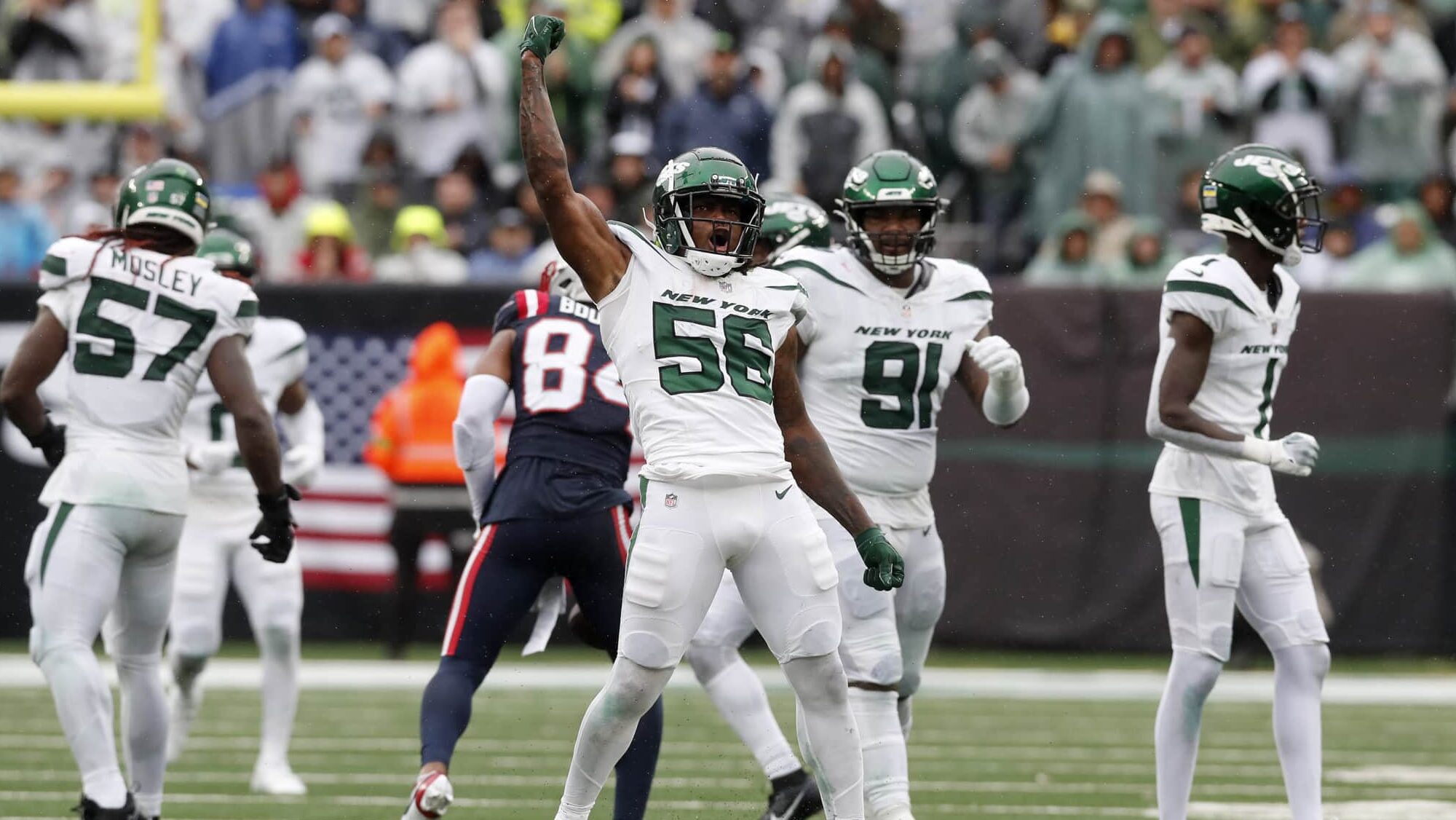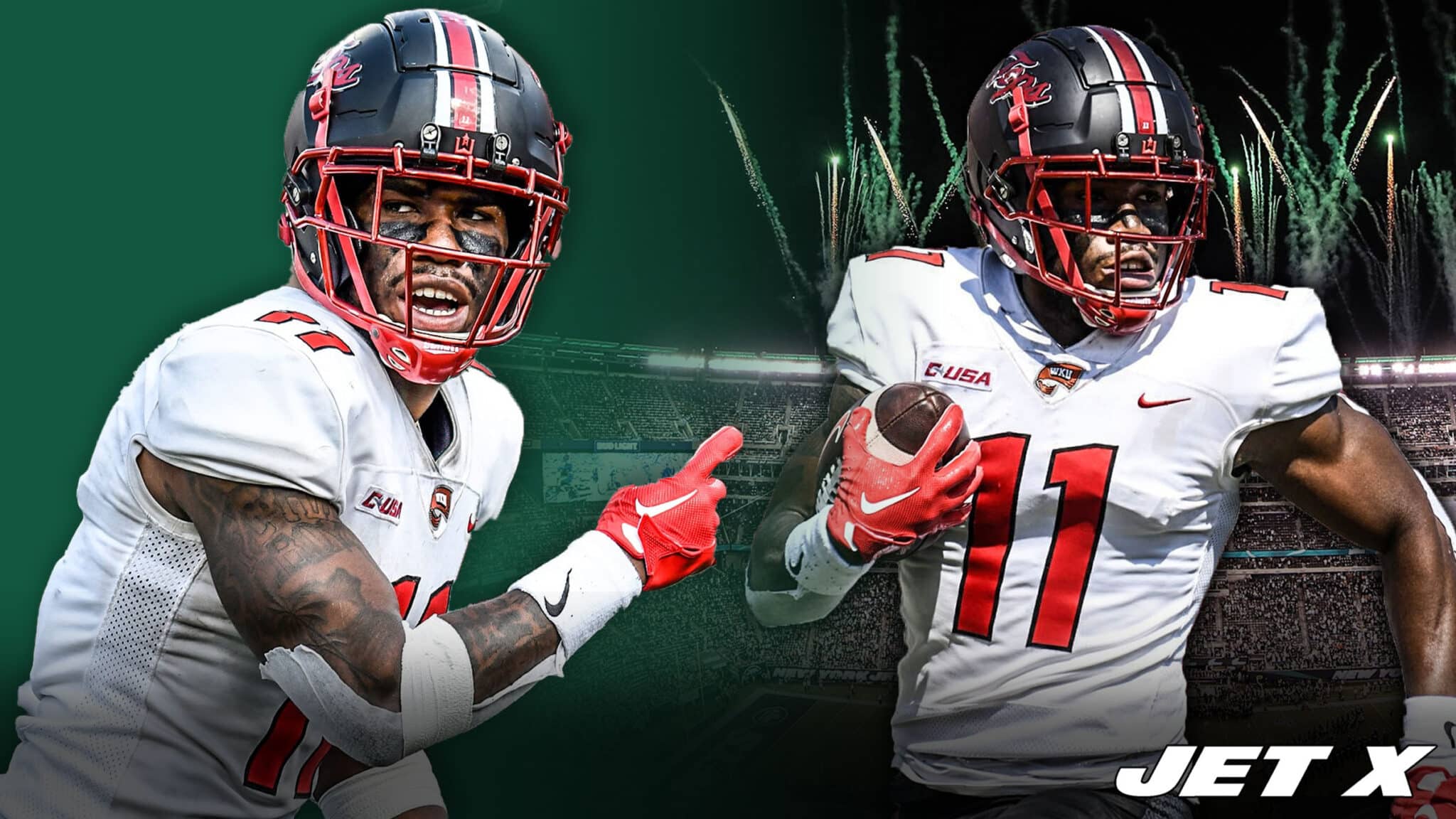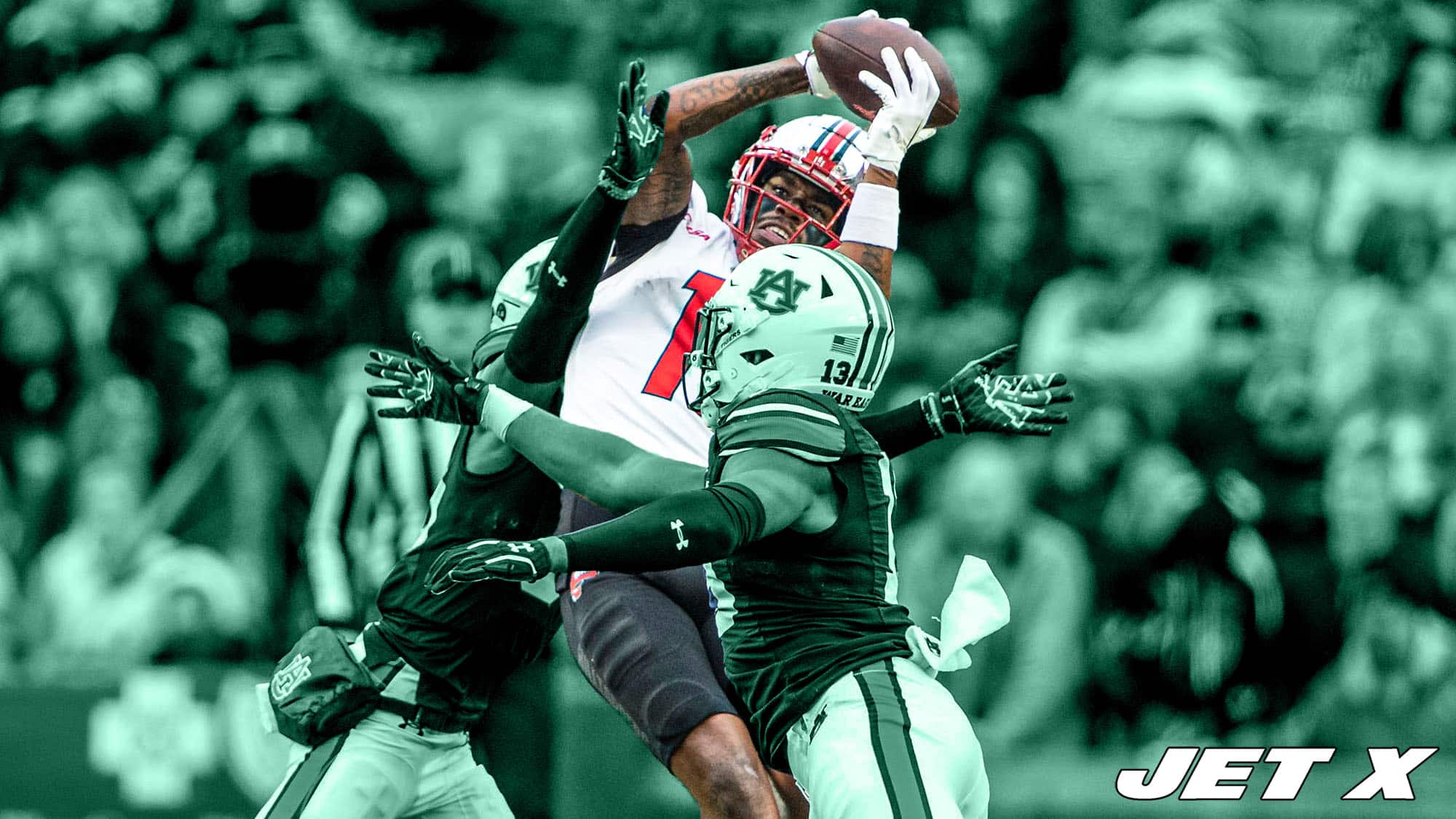The New York Jets’ linebackers have been busy, but have they performed well?
Heading into the 2023 season, the biggest weakness of the New York Jets’ defense was considered their linebacker unit. While safety was also a question mark, the loss of Kwon Alexander, the advancing age of C.J. Mosley, and the razor-thin depth at linebacker made it the primary concern.
At the de facto quarter-mark of the season, it’s worth reexamining that narrative. How have the Jets’ linebackers performed? Have they suffered from the loss of Alexander as much as feared?
Personnel usage
Of the Jets’ 298 defensive snaps, here is how they’ve allotted their linebacker usage:
- C.J. Mosley: 298 (100%)
- Quincy Williams: 289 (97%)
- Jamien Sherwood: 58 (20%)
- Chazz Surratt: 4 (1%)
While Mosley and Quincy Williams are clearly the starters, Jamien Sherwood‘s role is far diminished from Alexander’s in 2022. Alexander played 49% of the Jets’ defense snaps, while Sherwood is at only 20%. When Alexander was the third linebacker (outside of the two games Williams missed), he averaged 29 snaps per game; Sherwood is at exactly half of that thus far, averaging 14.5 snaps.
In part, this is because the Jets are playing a higher rate of nickel defense than they did in 2022. They’ve employed some form of nickel 77.5% of the time compared to 65.1% last year. 10.7% of their snaps have been big nickel (three safeties) compared to just 5.5% in 2022. As a result, their base defense usage is down from 25.7% to 17.3%. Still, Sherwood is playing almost exclusively in base or goal-line looks, while they used Alexander in other situations, too.
Quincy Williams
Williams is showing up all over the field so far this season. Linebacker statistics are difficult to accurately quantify, but he has some numbers that show he’s been a playmaker. Here are his numbers and percentile ranks (among linebackers unless indicated otherwise).
- 31 solo tackles (93rd percentile)
- 7.3% missed tackle rate (63)
- 12 run stops (95)
- 9.4% run stop rate (70)
- 6.0 yards per reception (86)
- 10% forced incompletion rate (85)
- 4 passes defensed (100)
- 82.6 targeted passer rating (76)
- 11 pass play stops (100)
Williams’ tackling improvement in the early going is tremendous. In 2022, he ranked 57th out of 72 qualified linebackers with a 14% miss rate. In particular, his 20.4% miss rate in the passing game ranked the third-worst. This year, he’s down to 5.3% through four games. Williams’ coverage has been suspect in the past, but if he can wrap up in the open field, that raises his floor as a defender tremendously.
C.J. Mosley
At 31, Mosley does not have anywhere near the speed that he used to. Still, he managed to put together a solid 2022 season, even if his Pro Bowl and second-team All-Pro berths came from reputation rather than actual performance.
So far in 2023, Mosley has been somewhat uneven. Here are his numbers.
- 27 solo tackles (84th percentile)
- 2.5% missed tackle rate (86)
- 6 run stops (56)
- 4.6% run stop rate (16)
- 12.4 yards per reception (8)
- 6% forced incompletion rate (72)
- 2 passes defensed (90)
- 76.4 targeted passer rating (85)
- 3 pass play stops (50)
Mosley’s targeted passer rating is somewhat skewed by the interception he recorded against Patrick Mahomes. He also has two dropped interceptions which could have helped his coverage numbers. Still, he was the defender charged with Isiah Pacheco’s 33-yard reception, and his 161 coverage yards allowed are the eighth-most among linebackers, while his 120 YAC allowed rank fourth.
Jamien Sherwood
Sherwood is qualified among linebackers only as a run defender, not in terms of overall defensive snaps or in coverage. Still, here are his numbers, with percentile ranks given only if qualified.
- 6.5% run stop rate (40th percentile)
- 4.3 yards per reception, 1 TD allowed
- 124.3 targeted passer rating
Sherwood has not made much of an impact on his run defense snaps, and he’s had only nine in coverage. That may be one of the reasons the Jets are playing more nickel.
As a unit
After the 2022 season, Michael Nania ranked all 32 linebacker units in the NFL based on five metrics: missed tackle rate, yards per target allowed, stop rate, touchdown/interception margin, and snaps per penalty. The Jets’ unit ranked 13th with an average ranking of 14.8 across those categories.
In 2023, only Mosley and Williams qualify among linebackers (min. 120 defensive snaps). Here are their combined ranks compared to the rest of the league.
- Missed tackle rate: 4.94% (6th)
- Yards per target: 6.12 (10th)
- Stop rate: 5.47% (5th)
- Touchdown/interception margin: -1 (T-2nd)
- Snaps per penalty: 292.5 (25th)
Using these numbers, the Jets’ linebackers have an average rank of 9.6, which is tied for the sixth-best mark among all teams. It’s worth noting, though, that the touchdown/interception margin numbers are likely the most premature and prone to variation due to a small sample size.
It seems fair to exclude Sherwood from these rankings considering his sparse playing time. Still, he did give up a touchdown, which is a blemish on the record of the linebacking corps that does not show up in this particular analysis.
Has Quincy improved in coverage?
Through four games, Williams leads all linebackers with a 90.2 Pro Football Focus coverage grade. Along with his 82.6 targeted passer rating and three pass breakups, that would seem to indicate that Williams has had a very strong start in coverage.
On the flip side, after three consecutive games with a coverage grade of at least 82.0, his coverage grade against Kansas City fell to 57.8 after he allowed 5 of 7 receptions for 37 yards (7.4 yards per reception).
I originally included a bunch of statistics from NFL Next Gen Stats in this section, and I’ll still add the abbreviated version. However, when you study the film of the Jets’ linebackers compared to their stats, you’ll notice that there may be many mistakes in coverage attribution (more on that later).
Here are some of Quincy’s most relevant numbers in coverage against running backs and tight ends, the players you’d normally expect a linebacker to cover. His ranks are compared to 66 qualified linebackers (min. 20 cover snaps against running backs and tight ends).
- -0.231 EPA per target (24th)
- 18.2% tight window percentage (<1 yard separation) (11th)
- 33.3% coverage success rate (45th)
- 1.4 yards per cover snap (45th)
- 45.5% open rate (17th)
It’s hard to reconcile some of these numbers with each other. He’s distinctly below average both in his coverage success and yardage allowed, but his EPA per target is better than average?
Furthermore, tight window percentage doesn’t mean much when you’re talking about a defender who covers the curl-to-flat area a lot. In zone coverage, there is necessarily going to be separation on such a play. In particular, the Jets’ defense is set up to rally to tackle anything in the flat but not necessarily to prevent catches in that area.
Tale of the tape
First, let’s take a look at his passes defensed (as tracked by Next Gen Stats rather than PFF). While linebackers rarely execute perfect coverage, it’s worth noting that in each case there was a window for the quarterback to complete the pass if they placed it better.
Still, Williams was right there on both plays, not beaten by a bunch of yards. There’s not much more that you can ask from a linebacker. There are also some plays where he stayed right with the running back on a deeper route.
Normally, when a quarterback sees a one-on-one matchup between a running back and a linebacker, that’s where they’re going with the football, but not here. Mac Jones finds somewhere else to throw, but Williams did a good job taking away Stevenson as an option.
Here are examples of Williams covering the flat and dump-offs. When it’s not a screen with blockers out in front, he’s generally done a fairly good job at limiting the damage. The main exception was a play where there was miscommunication on the Jets’ defense right before the snap. (It’s fair to wonder why they don’t call a timeout in those situations considering the havoc they’ve caused over the last couple of years.)
That being said, while Williams’ tackling in the passing game is much better thus far, it hasn’t been perfect. He will likely always be a boom-or-bust tackler with poor form and an urge to make the big hit rather than wrap up. Those throws to the flat will always be dangerous, because either he’s going to make a massive hit, or chances are there will be no other line of defense for quite a while. Here are a few examples.
In general, Williams’ strength is shooting gaps rather than maintaining leverage on blocks. You see it in the run game, where most of his great plays come with speed and elusiveness rather than taking on blocks head-on, and you see it in the screen game, too. When he’s able to knife his way through blockers, Williams can blow up a screen with his speed.
But when he has to come downfield and actually take on contact, he often comes in too high and seeks to run through the blocker rather than holding their spot. This does not allow other defenders to rally to the ball, thereby giving the receiver plenty of space with which to operate.
This is not to say that Williams has no power. He has plenty of it — but he often doesn’t leverage it properly in the open field. On traditional run plays, he is not running at full speed when taking on blocks, so it’s easier for him to stay low and take on contact from a position of power. While running at higher speeds, though, Williams struggles to attack blocks from an advantageous position.
What about Mosley?
For the same reason that I didn’t want to harp on Williams’ coverage numbers too much, I won’t harp on Mosley’s. With Mosley, though, it’s starker because of what they charged him with. While PFF doesn’t release their raw data for each play, we know that they charged Mosley with these two receptions (based on the stats for the longest reception allowed in each game).
This one is almost certainly on Jamien Sherwood. He stayed too flat, almost as if he was in man coverage on the tight end, rather than feeling out Lamb’s route, especially with the three-step drop.
On this one, there was clear miscommunication among the Jets’ defenders in the box about which player was responsible for which receiver in the full-house formation. Next Gen Stats charges the nearest man in coverage with the reception, and in this case, Mosley was the nearest man because the Jets blew the coverage.
It could have been Mosley, certainly. It appears that some players thought they were playing straight man coverage, while others thought that they were switching depending on the release. Considering that there were four players involved — from left to right on the defense, Ashtyn Davis, Mosley, Williams, and Adrian Amos — and all of them seemed to be expecting something either subtly or radically different, the best way to chalk this up is simply a blown coverage on all four players, or on the whole defense, or on the coaches.
Overall, Mosley’s 63.4 PFF coverage grade ranks 34th out of 68 qualified linebackers (min. 55 coverage snaps) — and that’s probably not too far off. Maybe that overrates him a bit, but the truth is that most NFL linebackers can’t cover all that well. The Jets’ scheme tends to expose the linebackers to more blame because of the soft zone; they rarely guard the underneath zones that closely, basically daring teams to dink and dunk their way downfield. (Look at how that worked out for Patrick Mahomes, the master dink-and-dunker. Maybe it’s not such a bad plan, after all.)
The biggest gripe fans will have is that Mosley already has two dropped interceptions in four games, and they were both right in his hands. He did nab a pick against Mahomes, but it’s the two he didn’t grab that stand out.
Outside of going 1-for-3 on interceptable balls and that questionable lapse against Kansas City, Mosley has been okay in coverage. Not good, maybe not even average, but close enough to it to be okay. Here are some examples, mixing in tight coverage with some lapses. There are times when Mosley’s coverage is fairly tight but the pass is complete anyway. That’s the life of playing a soft zone.
Are the LBs to blame for run D inconsistency?
Right now, the Jets rank 17th in the NFL in allowing 4.2 yards per carry. Perhaps run defense has just been better across the league to begin 2023, as the Jets posted the same mark in 2022 but ranked 10th in the NFL. They’re 14th in EPA per rush at -0.09 and 13th with a 38.7% success rate and 3.52% explosive (15+ yard) rate. Still, if you cut that number down to 10+ yards, the Jets rank 20th at 20%.
These numbers suggest that the Jets’ run defense is mediocre. Isiah Pacheco just ripped off four rushes of 10+ yards against them, and Patrick Mahomes converted three third-and-long plays on the ground, including a critical third-and-23. Ezekiel Elliott had 16 rushes for 80 yards against the Jets (5.0 per attempt) with three 10+ yarders. They’re allowing too many big runs.
It’s fair to wonder how much Mosley and Williams have to do with that since both have below-average PFF run defense grades. Mosley’s 65.2 mark ranks 38th out of 66 qualified linebackers, and Williams’ 63.8 ranks 41st. For Mosley, that mark is a decline from his 73.8 grade in 2022, but for Williams, it’s actually an upgrade from his previous 60.2.
Both Mosley and Williams have been somewhat inconsistent in the run game. Still, from watching the film, it appears that Mosley is more hot-and-cold and less impactful, while Williams, as usual, has a lot more thump but can still make bad mistakes.
One of Williams’ biggest struggles comes on toss plays. Just like on screens, he will often need to take on a block rather than knifing through to make the tackle. When he can cut through tacklers, a classic Quincy moment is often at hand, but when he can’t, a blocker of any capability level can usually knock him backward. Mosley has had this issue at times, too, but not as consistently as Williams.
Here are some examples of how both linebackers have handled these kinds of situations. Results can and do vary.
Nevertheless, both Mosley and Williams have had their fair share of rock-solid run defense. In Williams’ case, it’s often flashy, but he also does the dirty work to clog gaps and let others rally to make the tackle. He has an easier time maintaining leverage on run blocks when he’s not running full steam ahead into contact.
One thing noticeable about both Mosley and Williams, going back to 2022, is that they struggle to contain quarterback runs. Although the first line of defense is the containment of the defensive line, it’s very difficult to both rush the passer effectively and prevent any running lanes. Therefore, the linebackers need to pick up their defensive line at times.
When the defense is in man coverage and the linebackers have their backs turned, that’s also going to be difficult. It’s one of the reasons that being extremely predictable about when you play man coverage (ahem, third down) allows the quarterback to exploit the coverage. Notice that some of the most back-breaking quarterback runs against the Jets have come on third down.
Still, it’s also because Mosley has an exceptional inability to come up and make a tackle on a quarterback. When he sees the quarterback ready to run, instead of making any sort of move to come toward him and tackle him, he simply waits for the quarterback to come to him. Usually, that winds up right around the first down marker. Even an unathletic player like Mac Jones can usually get past a veteran 229-pound linebacker in that situation; for Josh Allen, it’s a piece of cake.
Meanwhile, even for a player in man coverage, Williams is exceptionally unaware when the quarterback run is coming. All over the Bills-Jets film from 2022 are plays where Williams still had his back turned several seconds after Allen took off.
I’m actually not referring to Patrick Mahomes’ runs against the Jets, as those seemed to be caused more by a breakdown of defensive line containment rather than the linebackers’ play. Credit Andy Reid for clearing out space for Mahomes to run (I have no doubt that it is intentionally schemed up that way). Here are a couple of examples — one each from Allen and Jones.
Then you have just the generally bad run defense plays from both linebackers, besides the outside runs shown above. Here are some examples.
From the film I watched, although there were definitely mistakes made by the linebackers in run defense, they do not seem to be the primary drivers of the Jets’ struggles. I saw a lot more poor edge-setting, interior defensive linemen getting blown off the ball and allowing blockers to quickly climb to the next level, and poor tackling angles from both the cornerbacks and safeties. The Jets need better from Jordan Whitehead, Tony Adams, Sauce Gardner, Quinton Jefferson, Al Woods, Solomon Thomas, Carl Lawson, Will McDonald, and Bryce Huff, to name a few.
That is not to absolve the linebackers from blame — I did just post film of their flaws. Still, I think Williams’ PFF run grade is a little unfair considering just how many big plays he makes compared to his mistakes. Mosley’s grade seems about right.
So how have the linebackers performed?
I didn’t focus much on Sherwood in this article due to his dearth of playing time, but I think it’s evident the Jets miss Alexander. He’s the main cog missing from their coverage unit in 2022 (other than Lamarcus Joyner, who was basically not there), and we’ve seen communication break down many times with Sherwood, Amos, and Ashtyn Davis on the field.
Still, if Williams can just keep up his improved tackling, that would be tremendous for the Jets’ defense. As a team, they have 38 missed tackles this season, the ninth-fewest in the NFL. Keeping the underneath plays underneath and limiting dump-offs to the flat is a key part of their defensive plan.
Still, Williams and Mosley both need to be more aware on toss plays and give the rest of the defense enough time to rally for tackles. The same applies to screen passes. Mosley, in particular, needs to keep his feet moving on quarterback runs and be more aggressive rather than sitting back and letting them easily pick up a first down.
Overall, though, Williams is going a ways toward justifying the $6 million per year the Jets spent on him. The linebackers haven’t been perfect, but they’re not the main reason the defense has yet to fire on all cylinders.












